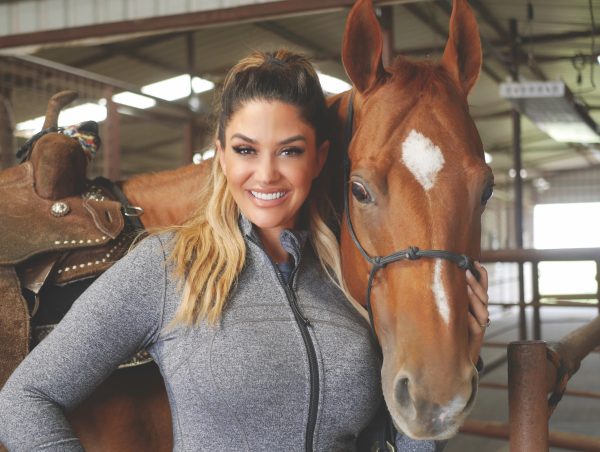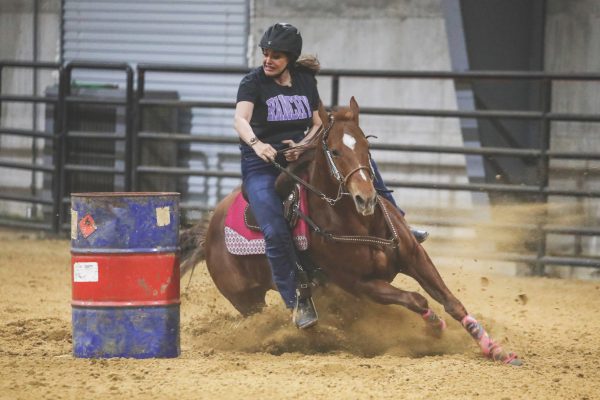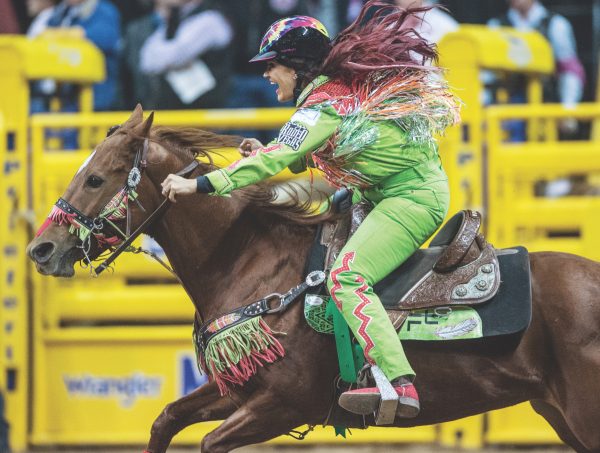You’ve probably heard of barrel racing superstar Fallon Taylor—it’s hard to miss her bold fashion choices, and she now spearheads her own company that sells clothing and horse gear patterned up in her signature style.
Fallon earned the titles of 2014 Women’s National Finals Rodeo (NFR) World Champion Barrel Racer and 2018 American Quarter Horse Association World Champion Barrel Racer. Now a businesswoman, she has a training and breeding farm and a supportive family. She credits her success to perseverance, goal setting, and having an irreplaceable mare named BabyFlo.
We chatted with Fallon to find out how she got her start with horses, what obstacles she overcame on the way to competing at the sport’s high- est levels, and how she created her colorful Ranch Dress’n retail business.

Fallon Taylor: The Beginnings
YR: What kicked off your interest in horses?
FT: I got to ride a pony at an event in Tampa, Fla., where we lived at the time. That was my first experience riding a little pony.
After that, I started watching rodeos on TV. My parents encouraged me when they saw that I had an interest. We went to Texas for my seventh birthday, and they took me to the rodeo. It was then that my life was forever changed. [Running barrels] was something that I wanted to be a part of. Within a year, we found a trainer, got a horse, and got my pro card.
YR: Not everyone gets a horse and lessons right away. What advice do you have for our readers in this situation?
FT: I know not everybody has that level of support. Finding people to support you is super important. I’ve seen people make it to my level by interning and trading lesson time at the barn for cleaning stalls.
YR: What were your first lessons like?
FT: I didn’t have much experience, but my goal was to run at the Mesquite Championship Rodeo. My first trainers weren’t trying to set me up for a lifetime career, they were just trying to help me run the barrel pattern. I had to go back later to [learn] the fundamentals of being an equestrian.
My advice? Get on as many different horses as you possibly can and do as many disciplines as you can, because there’s something foundational in each one.
YR: You said your goal was to go back and compete at the rodeo you first attended. How did you do there?
FT: I did terribly. But failing is where the nuggets of information come from! If I was young and starting all over again, the main thing I would tell myself is “failure is not bad.” Failure is something that’s part of the lesson. You can’t learn anything from victory, so learn to fail quicker. Don’t be afraid to go out on a limb and look silly or be embarrassed. Every single failure is the lesson you need to level up.
YR: You made it to your first National Finals Rodeo as a 13-year-old in 1995. How did you set that goal?
FT: I learned a lot about how to set goals from that first failure. I broke it down into pieces. First, I wanted to be the fastest barrel racer at the Mesquite Championship Rodeo. Then I wanted to break the arena record there. Then I wanted to make it to the National Finals Rodeo. All those things were on my goal sheet, and I just worked on them.
Resilience in Riding
YR: Can you tell us about your riding accident?
FT: I was training like usual one day. I always, always say, “Never ride alone.” I’m grateful that I wasn’t alone. I was riding with my assistant at the time and her boyfriend—who happened to be a paramedic. That was lucky for me. I ended up getting bucked off and breaking my neck and suffered from temporary paralysis. I had to be life-flighted to a hospital in Fort Worth. I had to wear a halo and had to learn to walk again. I was in the hospital for only about three days. I had a fear of hospitals, so I begged and begged to get out of the hospital. They told me that if I could learn to put one foot in front of the other, I could leave. A night nurse helped teach me to walk again. I was on my feet, and I left. I’m not 100 percent sure that I was supposed to leave, but I did. Still, I was in a halo—which was screwed into my skull—for almost a year.
YR: What did it take to return to riding?
FT: Right after I got the halo off, I was on a horse the next day. I was shocked by how weak I was and how much fear I had. I was scared to continue and had to work through that. I had to take it step by step. I had to remember that improving just 1 percent each day was enough. Just going to the barn in those first days was enough. Then just getting on a horse was enough. Then loping a circle was enough.
I finally started to gain strength back, and I set my eyes on something bigger. I’d been given a second chance—that not many people get with this injury—and I didn’t want to waste it. I set my eyes on going back to the NFR after a very long break.
In every single discouraging moment, you have to find the lessons so you don’t repeat them all later. Don’t think that whatever path you choose is right or wrong based on your failures along the path. Instead, make sure to learn the lessons along the way and apply those to the future. It’ll make your journey to your goal a lot more fulfilling and a lot shorter.

YR: Did anyone help you or inspire you as you recovered?
FT: Yes, [my mare] BabyFlo. I think that we’ve both had kind of a survival vibe. At that point, she just wanted to win no matter what the cost. At the same time, I had to win to pay my entry fees for the next event. We both had the same level of hunger, and she brought in so many cool people that would provide even more support. I really won’t ever be able to repay her. I try every day, but she just had a hunger in her that is hard to find.
I know for a fact that she would never have had the same win record with another rider. That doesn’t mean it’s because I’m so great at riding her—it just means we were an absolute match. We failed a lot, too. Knowing that she wanted to win as badly as I did made me want to pursue the next rodeo.
YR: What gave you the determination to power on?
FT: Trying to do more than what people think I’m capable of has always been at the top of my goal sheet. I was bullied in school, and I was home-schooled because it got so bad. I had to develop a thick skin. I was the horse girl in class—you know, the girl who just talks about horses, tells you about horses, shows you pictures of horses, and draws pictures of horses. But as I started to see how cool it was to compete, to take care of an animal, and to have so much responsibility, it taught me a lot of self-respect. I valued other people’s opinions about me a lot less. I started to value my own opinion.
Remember, you typically get picked on for something that is going to be your strong suit and make you
a success later in life. If you’re getting picked on for something, it’s probably the thing that’s going to make you successful. Bullies can sniff it out and try to make sure that your light doesn’t shine brighter than theirs. To everyone getting bullied: It’s you who will end up being the cool kid later.
With home school, I didn’t mind not having a room full of classmates because we were going to events every weekend. I was able to be around a lot of supportive, like-minded people.
YR: When did you decide you were ready to compete at high levels after your accident?
FT: 2012 is important because I decided that BabyFlo was ready to go down the road. I won a lot and
I ended up 16th in the world. I fell short of the top 15 (who compete at NFR) by $700. It was one of the most devastating failures of my career.
I sat at home and watched the NFR. I am so grateful for that failure because I learned how to be more organized when entering and how to keep track of my earnings and plan out my year.
Then in 2013 when I went back to the NFR, there were tears of joy as I was running back down that alley- way. I knew that I had run BabyFlo’s mother down that same alleyway.
Then at the 2013 NFR, I did horribly. I was one of the worst competitors. I won a lot of money, but I knew that my horse was better than how we ran. I hit barrels in every single round, and I was made fun of on TV. It sent me back into that same spiral of being made fun of.
Then I had to overcome and map out a different goal. All those tools I learned from being bullied when I was younger came back into play. I wasn’t starting from scratch, I was starting from experience.
In 2014, my goal was to be the person with the cleanest runs at the NFR. I began to train differently. I watched videos and met with mentors and tried to figure out what I needed to do differently.
Once I was at the NFR, I honestly had no intention of running for a world title, I just wanted to win the average. Again, I failed at winning the average. I was second due to a down barrel. But even though I was second, I ended up winning the World title, which wasn’t my first goal!
It’s like the saying, “Reach for the moon and you’ll fall among the stars.” When you reach for something, you’re going to learn, and there’s always going to be a big reward along the way.
Fun in Fashion
YR: When did your fun fashion taste start?
FT: Wearing bright colors was how everyone dressed when I started riding. It just happened that enough time passed between when I started riding and when I returned to the NFR that it looked like something crazy and new. It was just something that was derived from all the cool cowgirls before. There was even a fine back in the day for if you didn’t wear colored jeans! I came from that era, and I wanted to bring that back.
It was also a cool way for people to connect with me. On the back of a horse, everybody looks the same to the crowd. It was a way to see who I was.

YR: What’s it like to wear a helmet when not everyone does?
FT: I was not smart about going right to a helmet after my accident because I’d never seen anybody do it. I didn’t know what brands to look at until I went to the NFR in 2014.
I met a young lady through some mutual friends who gave me a helmet and said she’d love to see me riding in it. On the third round of the NFR in 2014, I decided I would try it. I knew I wouldn’t look like everyone else. But at this point, I had a hidden courage. I had endured so much bullying about everything else, I just thought, “What’s one more thing?”
When I put the helmet on, I realized how much confidence it gave me. Just like the people who bullied me when I was young—when you get bullied about something, it was probably going to be my gift.
This article about Fallon Taylor appeared in the July/August 2023 issue of Young Rider magazine. Click here to subscribe!


